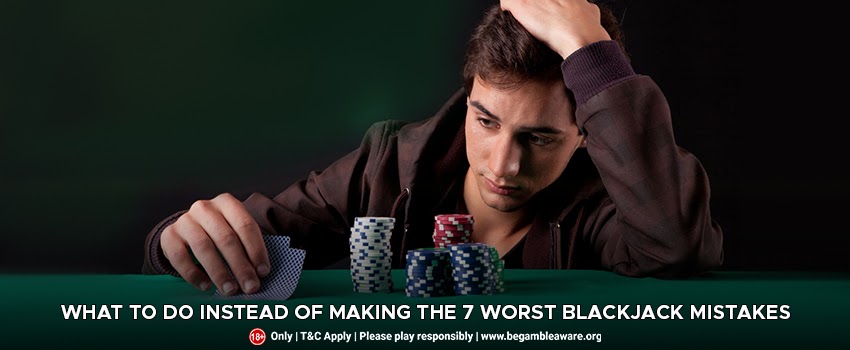What To Do Instead Of Making The 7 Worst Blackjack Mistakes

Blackjack’s fundamental theory is sheer chance. It’s a game of luck – Counting cards in a live casino or attempting to perform a blackjack plan on one of the many online casinos is always a gamble.
The cards will also work against you. That is not a sufficient excuse to succumb to irritation. You can’t opt to increase your bets to recoup any of the money you’ve lost at that stage. It’s possible that this would have tragic consequences. You will still make up for your blackjack mistakes or poor luck if you have any sensible strategies.
However, to achieve the game’s extraordinarily low house edge, you must be an expert player with a thorough understanding of strategy. The bare minimum of playing tactics needed to succeed at blackjack knows when to stand and when to strike. You must recognize that it is best to break, double down, or raise the stake.
1. Taking insurance
Taking insurance is the first of all blackjack mistakes on the list. If the dealer’s up card is an ace or a ten, many casinos now sell insurance. You will be paid 2:1 if the dealer has a blackjack. We’ve been conditioned to believe that having insurance for our vehicles, houses, and electronics is always a positive thing. As a result, it might seem normal to protect yourself from a possible blackjack. Insurance, on the other hand, is a ruse for a poor side bet. If at all practicable, avoid making blackjack mistakes like this.
2. Hitting a pair of 4s with a dealer showing a 5 or 6
Before playing the first game of blackjack, you may have looked at a few strategies. There’s nothing wrong with that; in truth, some of these tactics have proven to be very successful. Others, on the other hand, are the most common blackjack mistakes. When you hit on a pair of 4s, and the dealer reveals a 5 or 6, this is an example of this.
While some simple tactics warn against dividing on 4s, 5s, or 10s, there is an exception. If a dealer has a 5 or 6, splitting the 4s is the safest option. In this case, most players choose to strike to avoid busting a rough total of 8. However, if the dealer has a 5 or 6, he’s so likely to go bust that splitting the 4s makes sense. You can’t break because you hit too many times as you break, and you put more capital into play – it’s a win-win!
3. A lack of understanding of sign language
When it’s their time, blackjack players in the movies yell. Instead, most players use hand gestures to communicate their intentions. This not only prevents misunderstandings, but it also gives evidence to the surveillance cameras of their motive. As a result, not understanding sign language is one of the most common blackjack mistakes. Until the first game, familiarise yourself with simple hand gestures to know what you’re doing. Don’t get too worked up if you miss anything in the middle of the game. If it is appropriate, the dealer will gladly remind you.
4. Lack of clarity of thought
Blackjack is primarily a statistical game that relies on chance and strategy. The game necessitates a clear mind. You should learn the discard pattern and focus on card counting. If you consume too many free drinks in the casino or are tired, you will be unable to focus and keep track of the game’s progress. This type of play has only one outcome: large amounts of money are lost.
5. Splitting 10’s
It’s enticing to break tens because a hand that begins with a single ten-valued card is a decent way to get started. However, it is still a mistake that a hard total of 20 is so fantastic that the dealer can only occasionally beat you. After all, she requires a 21 to defeat a 20.
Many blackjack players can break 10s if the dealer has a 2, 3, 4, 5, or 6 shows. They are hoping that the distributor will go bankrupt and that they will be able to double their money in play.
However, you’ll win more often with a total of 20 than with two hands, beginning with a 10 by such a large margin that you’re better off standing on the rough total of 20.
By the way, this is one of the terrible blackjack mistakes. A player who splits only when the dealer reveals a 6 loses $52.85 for every $100 bet.
6. If the dealer shows an ace, stand on a hard 16
It hurts to reach a rough limit of 16, and you’ll almost always bust. However, often the smart decision is a losing move in the long run. It’s just a matter of wasting LESS money than you would if you had the other path. And you would most likely fail. But if you don’t strike, the dealer’s chances of winning with an ace are so high that you’ll risk more money in the long run.
Although it is uncommon these days, some casinos have a “surrender” alternative. This means you forfeit half of your bet before the hand is completed.
If you have the choice, surrender with a hard 16 if the dealer has a 9, 10, or an ace on the table. In this case, the blackjack mistakes lose $14.94 on every $100 bet.
7. Assuming that a Betting Progression must be effective
During a game, the house edge barely moves. If you use a betting progression, you’ll just end up in a situation where you’ll have to keep the stakes. If this is a losing series with no surrender option, you can imagine what will happen. The house will clean you out if you are attempting to beat with a betting progression. While the strategy is entertaining, the house always has an advantage, and the odds of losing increase with each hand.
Final remarks
Everyone speaks about how fantastic the chances are in blackjack, but they always forget to mention that the odds aren’t so great if you make mistakes. However, if you can prevent the 7 blackjack mistakes outlined in this article, you’ll be getting as good to the best possible chances as anybody could hope for. Nonetheless, it’s still best to memorize the whole basic plan. Overall, it’s not so difficult to do.
If you like playing blackjack online, there is one more blackjack mistake to be aware of. There are a plethora of casino sites available on the internet, but they aren’t all of the same quality, and some have dubious reputations. Playing at the wrong places will lead to a negative experience, so be careful where you want to play.
Name: What To Do Instead Of Making The 7 Worst Blackjack Mistakes
Posted On: 23/04/2021
Author: Cameron Riddell


